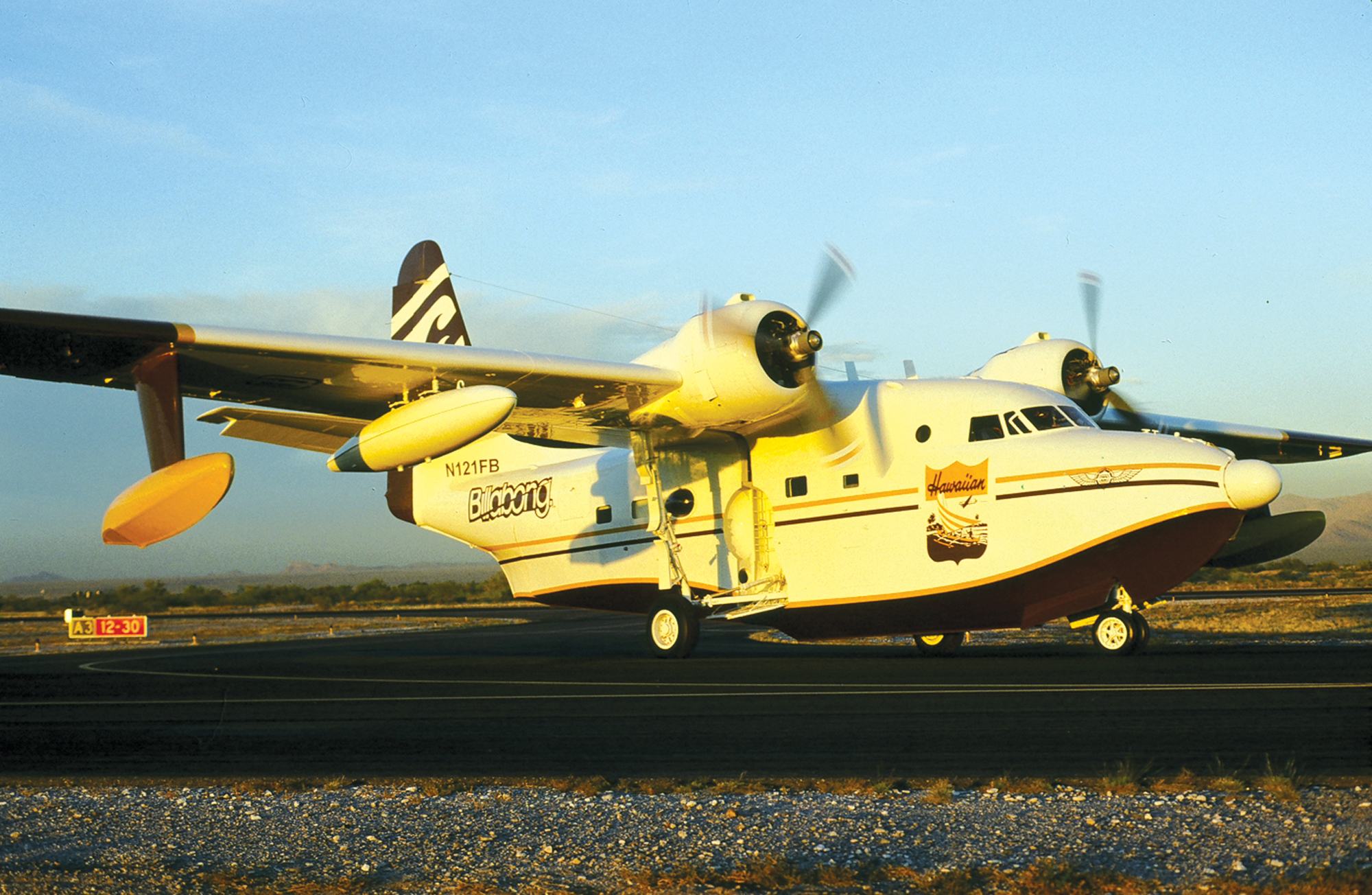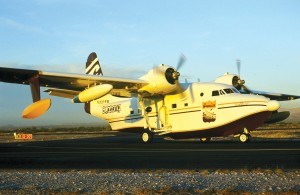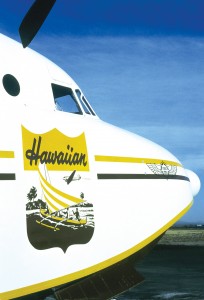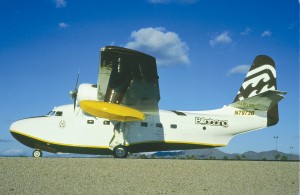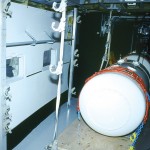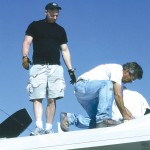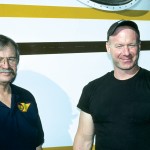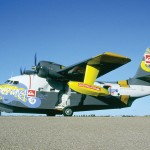|
By Bob Shane
When it comes to passion, nobody is more passionate about what they do than professional surfers (perhaps even more passionate than pilots). They’ll travel to the ends of the earth in pursuit of the perfect wave. The world of surfing can be a life-and-death adventure as surfers explore the seven seas, hoping to find and ride the biggest wave nature can spawn. Looking for that Mount Everest of wave surfing, these hardcore surfers challenge their mortality, attempting to ride a six-story avalanche of water. This high drama action sport is played out around the globe, from the shores of Northern California to the outer shoals of Maui and Oahu, to the treacherous barrels of Teahupoo in Tahiti and the many reefs off the coat of Australia. A new mission for the Albatross |
The surfing community, by nature, perpetually searches for new surfing locations. This quest to scout the planet, exploring the world’s oceans for surf in remote, pristine and relatively unpopulated regions, has historically been facilitated by the use of boats and aircraft. Paul Naude, the president of Billabong USA, has taken this global search to the next level.
The use of a large seaplane is the latest development in what Billabong calls “maximizing the surfing experience.” The company’s “Billabong Clipper,” a vintage G-111 Grumman Albatross recently outfitted to be the ultimate surfing exploration aircraft, made its maiden transpacific flight from Oakland, Calif., to Honolulu on Dec. 13, 2005. It took over 15 hours to cover the 2,094 nautical miles of open ocean.
The project was the brainchild of surf industry icon Paul Naude. His fascination with seaplanes goes back to WWII, when his father was a seaplane pilot in the Royal Air Force.
“I used to love that old TV series, ‘Tales of the Gold Monkey,’ with the old Grumman Goose set somewhere in the South Pacific,” Naude said. “I’ve always dreamed of using a big seaplane to search for waves. What surfer hasn’t?”
That TV show premiered in the early 1980s. Set in the South Pacific in 1938, it was about the adventures of a seaplane pilot and soldier of fortune named Jake Cutter. It combined the romance of the seaplane (“Cutter’s Goose”) with the scenic beauty of the South Pacific and was a favorite of seaplane enthusiasts.
This project is the first time that a large amphibian will be utilized for a surfing mission on such a grand scale. When the “Billabong Clipper” leaves the Hawaiian Islands, its flight plan will be to navigate the South Pacific, traveling to less known locations, prospecting the region in the hopes of discovering new un-surfed beaches.
Significant success in this area could be a marketing and public relations bonanza. Consequently, these flights will be shrouded in secrecy. It would be customary for all passengers participating in these expeditions to be required to sign confidentiality agreements not to disclose any new locations.
Rumor has it that when Billabong’s archrival Quiksilver learned of their plans to utilize a large seaplane to promote the Billabong trademark and seek out perfect waves, it briefly fielded an Albatross with a similar mission in an effort to scoop them. Replete with Quiksilver logo decals, an HU-16 Albatross rendezvoused with Quiksilver’s surf exploration motor vessel, the “Indies Trader,” at anchor on the Mississippi River, in late 2004.
“While the Quiksilver Crossing takes safe harbor on the banks of the Mississippi and awaits some relief from the deadly storms that have devastated the East Coast of the USA, the seaplane will be continuing the surf exploration duties in one of the most un-surfer-friendly coasts you could think of,” stated an entry in the daily captain’s log, dated Sept. 23, 2004. “Tom, Peter and the seaplane will be leaving tomorrow and heading north–straight into the cold–and chasing some of the massive swells that have been generated by the recent Atlantic storms.”
After conducting a proof-of-concept flight on the Mississippi, the HU-16, owned and piloted by Bill DaSilva, went on to Halifax, Nova Scotia. There the aircraft made several surf exploration flights, landing in the water, putting out surfers and discovering some new surfing locations. A neat thing about these flights of discovery is the tradition that the first person to surf a new breaker gets to name it.
Billabong’s surfing roots go deep
Billabong’s roots are in surfing. The company started in Australia and expanded globally. Its main forte and bread and butter is clothing. The company makes the best board trunks in the world. It seeks to satisfy the youth market, which aspires to action sports and the California lifestyle.
A team of athletes including Andy Irons, three-time world surfing champion, promotes Billabong’s products. In the action board industry, Billabong is the top tier surf brand in the U.S. marketplace.
The Albatross is up to the task
Billabong’s choice of the Albatross to find the best surfing locations in the world is a perfect fit. The Grumman Albatross is a rugged amphibian, originally built for the Navy as a utility transport capable of performing air-sea rescue. It made its first flight in 1947 and saw duty with the U.S. Navy, Air Force and Coast Guard in the search and rescue role.
Designated a UF-1 in the Navy and SA-16 in the Air Force, in 1962, under the Tri-Service aircraft designation system, it was re-designated the HU-16. After the Albatross was surplused, Grumman produced an upgraded 28-passenger conversion of the aircraft, bringing it up to commercial airline standards. It was designated the G-111.
First the aircraft was inspected and any parts needed to achieve a zero time airframe were replaced. The flight deck was modernized and two additional cabin doors were added. The two 1,475-hp Wright Cyclone R-1820 radial engines were overhauled and a new fire detection and auto prop feathering systems were installed. On the center wing section, titanium spar capstrips were installed, giving the airframe an unlimited service life.
The first G-111 flew in 1979, receiving FAA certification in April 1980. In total, the original manufacturer converted 13 Albatrosses to G-111s.
Billabong shops for a seaplane
When Billabong went shopping for a seaplane, every large seaplane type that was still serviceable was considered. This process included looking at more than 15 Albatrosses. It was concluded that only the B model Albatross, with a long wing, was appropriate for the long-range surf exploration mission. According to Billabong, “safety” was the number one priority.
On Dec. 13, 2004, the first Albatross in Billabong colors, an HU-16B, made an ocean landing off Newport Beach, Calif., and moored in scenic China Cove. It was its maiden flight after being painted in Kingman, Ariz. On board were professional surfers Shane Dorian and Donovan Frankenreiter.
After further consideration, it was decided that a G-111 would be preferable to an HU-16B. One reason was that the HU-16B was a “restricted” category aircraft with operating limitations. The G-111 was re-type certified into the passenger category, giving it broader operating latitude.
The G-111 that Billabong purchased was registered N121FB. Almost all of the G-111s had spent the majority of the time since their conversion in storage. Billabong’s was no exception. It was stored at Pinal Airpark in Marana, Ariz., during the late 1980s and went into storage again in the late 1990s in Mesa, Ariz.
Consequently, there’s a lot less time on the airframe than the years would indicate. The aircraft destined to become the “Billabong Clipper” was withdrawn from storage at Falcon Field in Mesa in April 2005 and flown to Mohave, Calif. Later, it went to Kingman, Ariz., for a Billabong paint job, then to Marana Regional Airport to be retrofitted for its new mission.
Once there, ATW Aviation, a full service warbird maintenance and restoration facility, supervised or preformed the required scope of work. All new side windows were installed. The cabin was outfitted with a stretcher holder, which doubles as storage for surfboards. A modern avionics package and weather radar system was added. Wing-mounted fixed fuel tanks were attached under each wing and the military door was reinstalled to accommodate the sea stairs.
ATW designed and installed a ferry tank system consisting of two 250-gallon fuel tanks originally used on a KC-97 tanker. This system would provide the additional fuel desired for that long haul across the Pacific from Oakland to Honolulu.
ATW did an outstanding job getting the “Billabong Clipper” ready for service. On Dec. 8, 2005, the aircraft departed Marana for Oakland, and then made the Pacific crossing on Dec. 13. It arrived in Hawaii during Billabong Maui Pro 2005.
Billabong goes Hawaiian
The origin of surfing is distinctly Polynesian. Surfing is one of the two big gifts Hawaii gave to the world; the other was the hula. Today, women are the fastest growing group in surfing.
“Women are a great audience for Hawaiian leisure airlines,” said Kirk Smith, senior director of advertising and promotions for Hawaiian Airlines. When Hawaiian Airlines provided the Pacific’s first scheduled passenger air service in 1929, they did it using the Sikorsky S-38 Amphibian.
It would appear that Billabong and Hawaiian Airlines have a lot in common, including surfing, seaplanes and a pioneering spirit. Consequently, when Billabong approached Hawaiian Airlines about being a sponsor of the recent women’s surfing event, the Billabong Maui Pro 2005, the answer was positively yes.
Hawaiian Airlines is also a sponsor of the “Billabong Clipper.” Emblazoned on each side of the Albatross is a Hawaiian Airlines promotional logo that was used by the airline in the 1940s, during the DC-3 era. The airline’s advertising group sees the romance of the aircraft as a throwback to the era of the glamorous flying boats and its origin as an airline.
Looking for the perfect wave
Billabong will soon be putting its multimillion dollar Albatross investment to work. According to Graham Stapelberg, VP of marketing for Billabong USA, the next scheduled port of call for the G-111 will be the Billabong Pro Tahiti surfing event in May.
The company is currently involved in developing a mission plan that will take the Albatross across the Pacific, ultimately ending up in Australia. Billabong also hopes to augment the Albatross’ capability by adding a pair of personal watercraft, one carried under each wing.
Reconnaissance flights and expeditions will be organized that typically will consist of 10 passengers and a two-man flight crew. Surfers, including big wave riders, and cameramen, will document each trip.
When the “Billabong Clipper” departs on its flights of discovery, it will be searching for not only the biggest waves, but also for what surfers call high-performance waves. These are the waves dreamed about by the average surfer. In essence, the “Perfect Wave!” Bon voyage to the crew of the “Billabong Clipper.”
For more information, visit [htt://www.billabongclipper.com].
- The interior of the “Billabong Clipper” shows the area for securing surfboards and the two 250-gallon ferry tanks mounted on the floor.
- Crew training takes place in the HU-16B at Falcon Field in Mesa, Ariz.
- Tom Parsons (standing), Billabong’s chief pilot, helps ready the G-111 for service at Marana Regional Airport.
- L to R: Bill Muszala, president of ATW Aviation Inc., and Tom Parsons, Billabong’s chief pilot, take a timeout from their tight schedule.
- The “Billabong Clipper” flight deck and some of its upgraded instrumentation.
- Bill DaSilva’s HU-16C wears Quiksilver decals.











